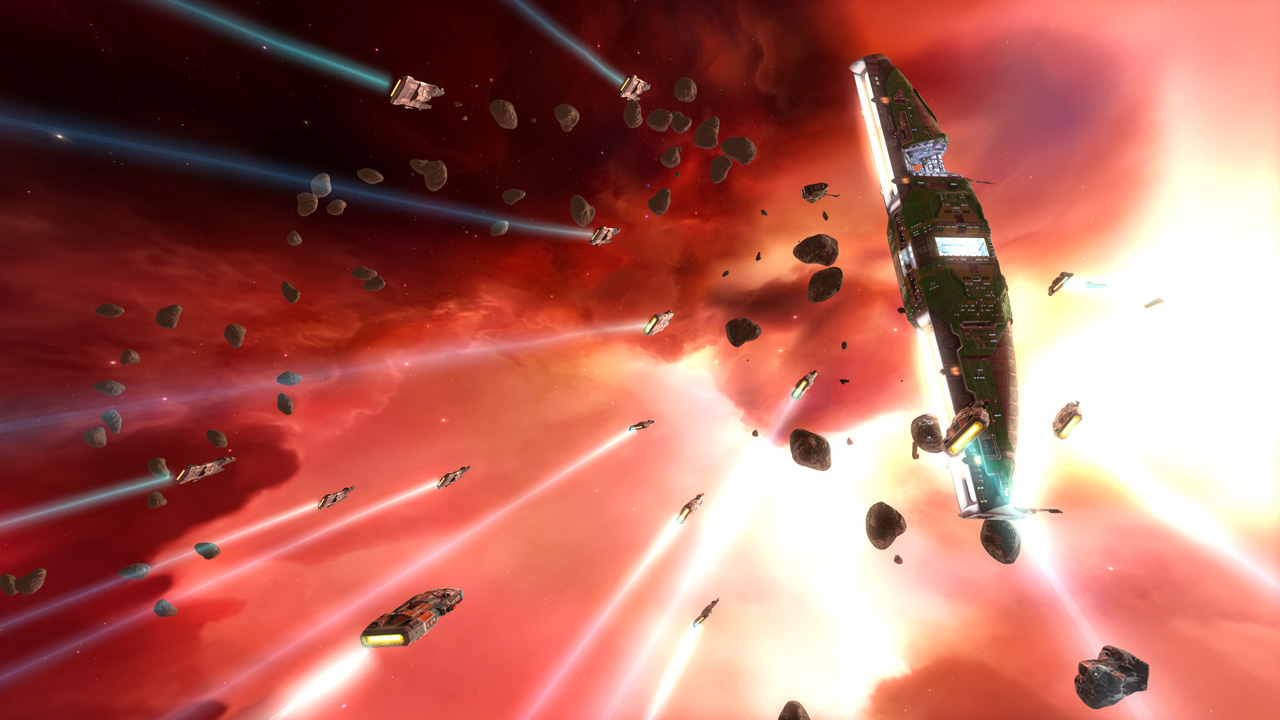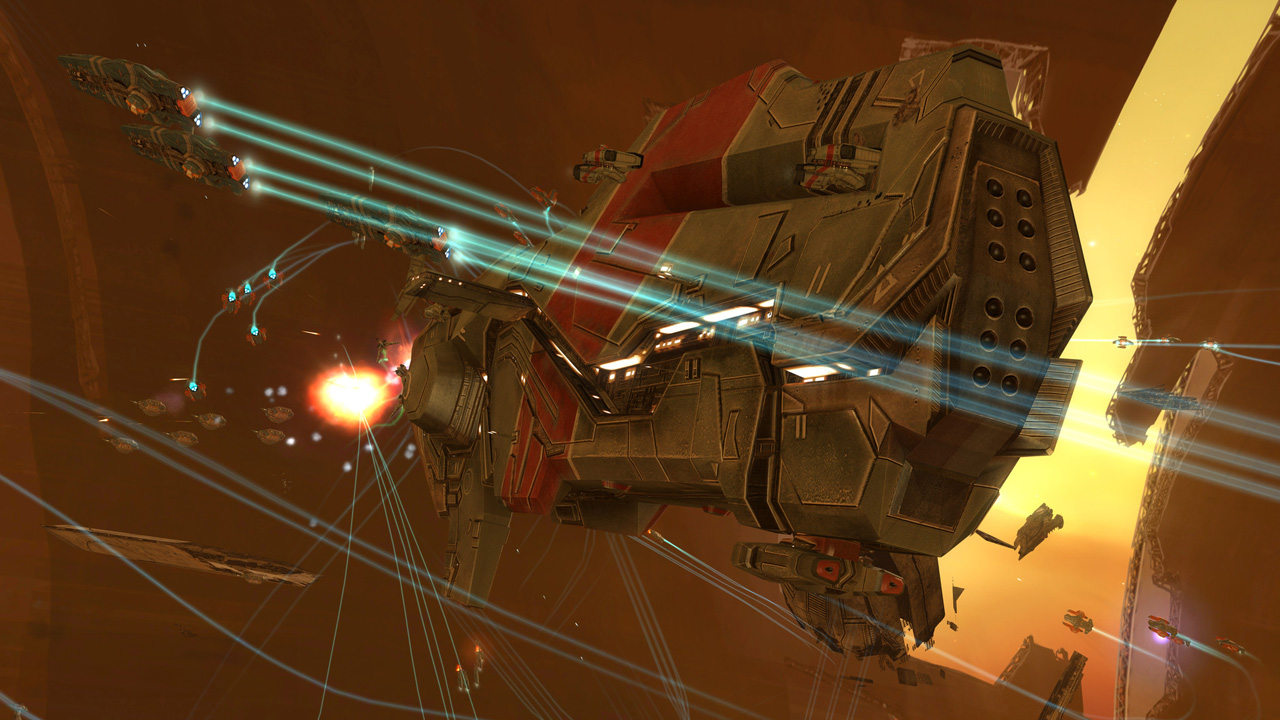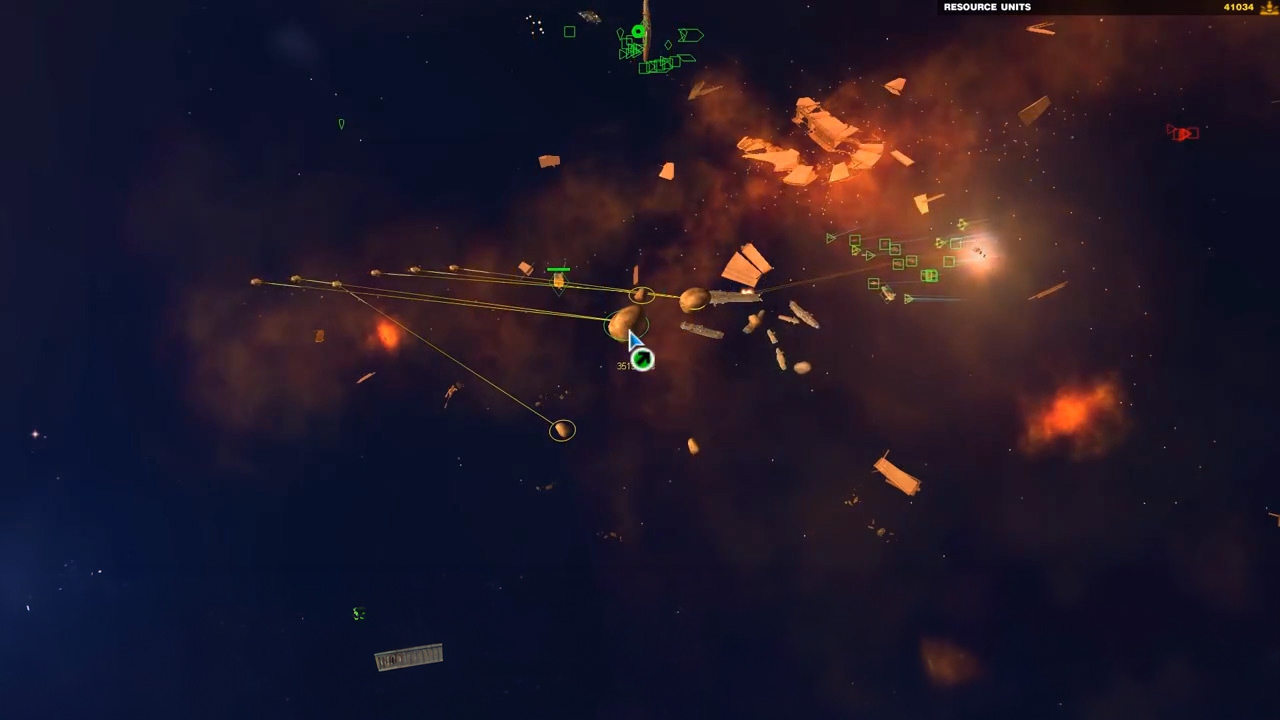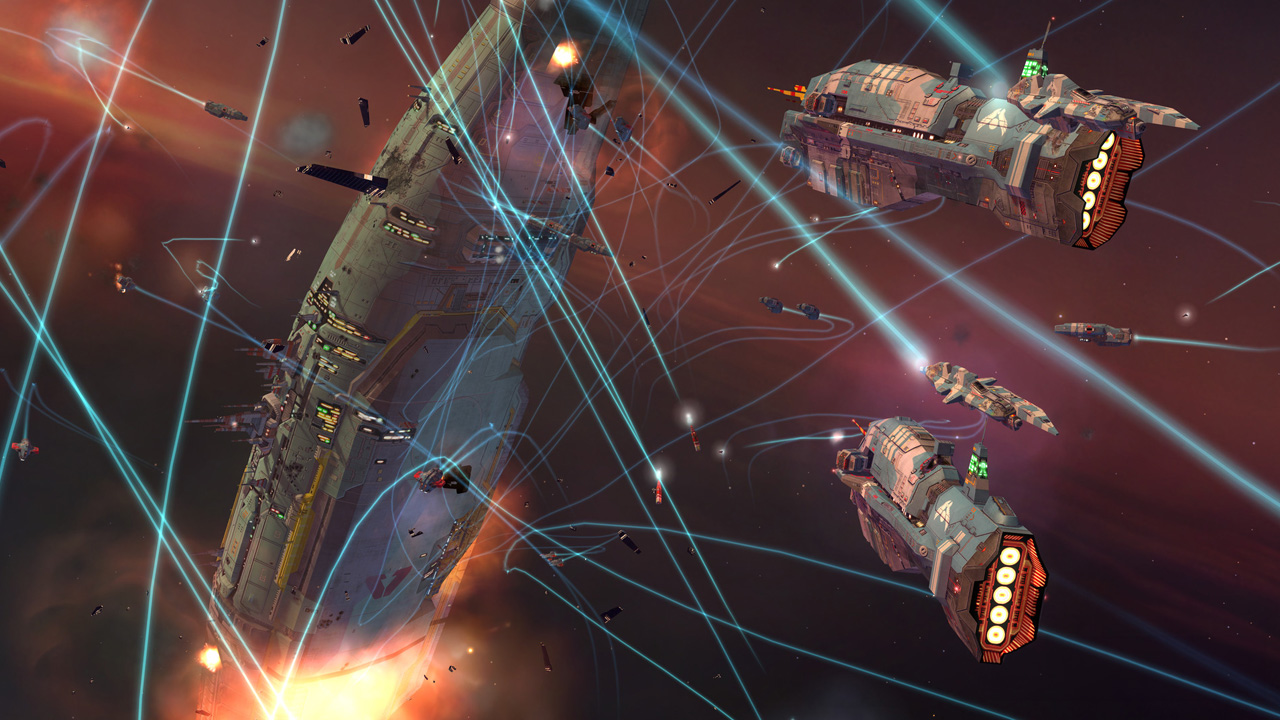Homeworld Remastered Collection can be summed up with one simple noise, the ominous bassy rumbling that occurs every time your ships jump into and out of hyperspace. Defining a game with noise is a rubbish way to begin a written review. However, with the power of the “internet,” I can make this noise by getting you to click on this pretty colourful text. Seriously, click on it, listen, and then come back. I’m not going anywhere. Okay done? Perfect. Everything Homeworld makes you feel is contained in that short sound bite. The emptiness of space, the fear of constantly jumping into the unknown and the hopeless futility that you are the last few of a destroyed civilisation being relentlessly pursued by a genocidal enemy. Wait…that sounds a lot like the plot of Battlestar Galactica!
Homeworld is, in essence, the video game version of Ronald D. Moore’s reimagined Battlestar Galactica series, but it was released a good five years before that was even a thing! Now, almost 16 years after its original release, Homeworld and its sequel have been re-released in glorious HD. Remasters are ubiquitous in gaming these days, but playing the series for the first time without the benefit of nostalgia, is it still a classic RTS?

Homeworld follows the Kushan, a civilisation confined to the desert planet Kharak. The Kushan find a colossal spaceship buried in the Great Desert, and within it are the coordinates of the planet Higara, their true home. Using the technology found on this ship, they develop a mothership capable of crossing the galaxy and returning to their ancestral home. After a brief hyperspace test, the mothership returns to find Kharak on fire, with no signs of life remaining and only a few hundred thousand colonists remaining in suspended animation. With an unknown enemy on their tails and minimal supplies, they head for Higara. As mentioned in the intro, the similarities to Battlestar Galactica are obvious, and, as a massive fan of the show, I really got sucked into the Homeworld universe. The story of the Kushan is told through a series of short, minimalistic cutscenes before every mission, and it is simple yet engaging. Like every other game aspect, these are remastered in HD, and Homeworld is now truly beautiful. Homeworld is also an odd game as far as Real Time Strategies go. In some ways, it’s a bog standard RTS – you have a mothership that builds all your units, you collect resources to pay for these units, and you research a variety of tech to gain access to bigger and more powerful units.

Some key differences set Homeworld apart from most games in the genre. Space is, generally speaking, pretty empty. Once you remove the planets and stars, there’s not much else left to fill your game world with. Yet Homeworld does just that. Barring a few exceptions, basically every level in Homeworld takes place in an empty black cube and all the usual map-related tactics associated with an RTS are thrown out the window. There are no choke points, no high ground, and just space. It really shouldn’t work at all yet; due to some fantastic unit design and an innovative 3D movement system, it ends up being one of the best RTS I have ever played. At its essence, it’s all one big game of rock-paper-scissors.
Fighters are small and manoeuvrable and at high numbers. They can be a real nuisance to your fleet, yet they can be dealt with by a decent squadron of corvettes. Corvettes pack a decent amount of firepower but can be reduced to rubble with a battalion of frigates. Huge hulking capital ships like the Destroyer can deal devastating damage to an opponent’s collection of frigates. Yet, a squadron of small, manoeuvrable bombers can deal with that. Being attacked by these bombers? Well, dispatch some more fighters to pick them off before they launch their payloads and keep pressing the attack. Each of these units is introduced to you slowly throughout the campaign, teaching you the nuances of the game piece by piece.
As you delve deeper into the campaign, the nuances become more apparent. Each of these broad ship categories contains a whole host of units and, with them, a variety of strategies. Support corvettes and frigates can help repair damaged units, drone frigates unleash a devastating swarm capable of dealing with large fighter squadrons and salvage corvettes can sneak up on unsuspecting enemy crafts, board them and transfer them to your control.

The most exciting ships in the world can not save a game from a lacklustre combat system. If all you’re doing is smashing two armies together in an empty black map, then it will get boring, fast. Of course, this isn’t the case. The maps in Homeworld might be empty, but you get to utilise all of that emptiness with whole 3D movement. Rather than sending your entire fleet straight towards the enemy, you can first send them up to the top of the map way above the enemy’s radar before heading back down to surprise the enemy from above.
It opens up a whole host of strategic options – perhaps you could split your fleet in two, one as a decoy to pull the enemy capital ships towards you whilst a second, much more extensive fleet of bombers swoops in from above. You could hide salvage corvettes in the far reaches of the map, sending them in to pick off valuable enemy ships and add them to your fleet. It can be rather tricky to pull off, however, by zooming right out to sensor management mode and assigning several waypoints to all the different ships in your fleet. Homeworld is generally a pretty tricky game.
I often forget that, excluding Dark Souls and its ilk, games were generally a lot less forgiving in the past, and this is no exception. Autosaves are almost non-existent, there is very little hand-holding, and mistakes are severely punished. This is exacerbated by the fact that every mistake you make at one level is carried over to the next. In most modern strategy games, each new level hits the reset button. You get a new base and a new pool of resources and build your army afresh before marching out and destroying the enemy. The remaining Kushan population, with its sole mothership and limited resources, don’t get that luxury. You start each level with what survived the last. Sure, you might complete a challenging level that you’ve been stuck on for weeks, but if you lose 90% of your fleet in the process, then you’re probably not going to make it through the next mission.
It is tough, it is innovative and it is practically unheard of in today’s strategy games yet…. it’s awesome. It adds another dimension to the already complicated battle system. You do not just want to win you want to win decisively. It’s also amazingly thematic. Loosing a ship doesn’t just weaken your army it brings you closer to extinction, every death is another soul you really cannot afford to lose.

Despite all this praise, there is a lot about this Remastered Collection that is….incredibly infuriating. Ignoring the beautiful HD remaster, Gearbox has done very little to update Homeworld, aiming to maintain as much of the original game as possible. Annoyingly, this seems to include bugs, too. As mentioned above, the third level of Homeworld begins with the mothership returning to Kharak on fire. All life on the planet is dead, and all that remains of the Kushan civilisation is contained in six Cryo Trays floating in space. One of these Cryo Trays is currently under attack from a group of unknown attackers. Your mission is to destroy the attackers and transfer the remaining Cryo Trays to the mothership. However, if you manage to save all six of them, the game glitches out and refuses to continue. This bug has been in the game since 1999 and is still present today! You’re punished for being good at the game because the game assumes it’s impossible to save all six ships.
There are a whole host of other bugs that hampered my enjoyment. The game has serious issues with loading save files made during a mission. Starting a mission from the beginning is fine, but load up halfway through, and often, it can not handle it. Cutscenes do not happen, enemy ships do not appear, and the level refuses to progress. This is particularly annoying in the game’s more demanding and more extended missions. There are other issues that aren’t necessarily bugs but are annoying nonetheless, and when coupled together, it feels like the game punishes you for knowing what you are supposed to be doing.
I had played one mission a few times, and after a few failed attempts, I finally figured out how to win. All I had to do was defeat a few smaller ships and then send a salvage corvette in and investigate a mysterious ghost ship. So, I loaded it up again and did just that, but it glitched, and the level would not proceed. So I loaded it again, this time from the beginning of the level, and finally made my way through the mission. I quickly dealt with the smaller ships and sent my fleet back to base whilst building a salvage corvette….but the game didn’t expect me to do that. It expected me to leave my fleet by the enemy, and once they moved away, the location of the ghost ship was lost. I spent a good 20 minutes looking for the damned thing before realising that space really is big….and also realising that I’d have to start the level….again.

It really feels like the game is punishing you for knowing what to expect and preparing accordingly. With ships so valuable, between missions, preparation is often the only way to succeed, and it sucks that it sometimes ruins my enjoyment of the game. Ignoring all of this means you have a great game, but can it simply be ignored? HD remasters often succeed and sell well, thanks to a hefty helping of nostalgia. My collection is filled with such games. If I was not such a fan of Metal Gear Solid, I would heavily criticise its HD collection for the excessively long cutscenes and the nonsensical plot.
Yet, those games were my childhood and no amount of CODEC calls can destroy my love for those games. With Homeworld I do not have the benefit of nostalgia. Sure, I had heard about it before but I never played it, never loved it when I was younger. I have no distant fond memories I just have what I have experienced so far and that makes it a lot harder to forgive any annoyances.
What is my final verdict on the Homeworld Remastered Collection? Honestly…I do not really know. I can not deny that it is fantastic, possibly a classic, but I also can not deny that it annoys the hell out of me. Your enjoyment of Homeworld will probably be based on whether you have played it before and how willing you are to accept a few bugs. These bugs may be patched out, but considering one has been in the game for nearly 16 years, I find that rather unlikely.
James
This is probably the most boring RTS I’ve ever played. As the author says, “If all you’re doing is smashing two armies together in an empty black map then it’s going to get boring, fast.” And that basically is all you’re doing. Every mission is basically the same. Gather resources until it’s all gone, max out your fleet then throw it at an enemy waiting for you to smash them. Wash, rinse, repeat, every mission is basically the same. I love RTS games but this one is a massive disappointment.